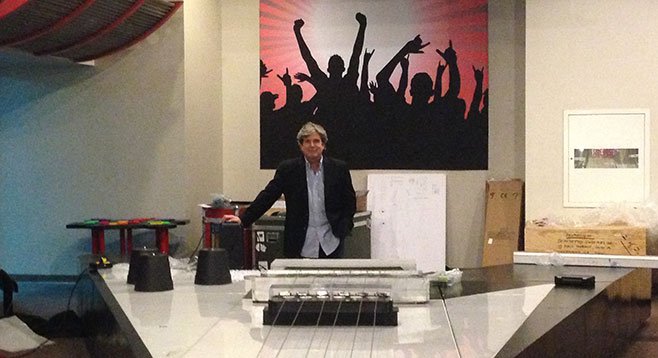 Facebook
Facebook
 X
X
 Instagram
Instagram
 TikTok
TikTok
 Youtube
Youtube

“It’s 43-and-a-half feet long and is almost ten years old and was built by a science academy in Texas for the express purpose of winning the world’s largest playable guitar award,” says H.P. Newquist about the giant replica of a Gibson Flying V guitar. Newquist is the executive director/founder of the National Guitar Museum and the man behind Guitar: The Instrument That Rocked the World, a touring exhibit that will be at the Reuben H. Fleet Science Theater in Balboa Park from December 20 to April 6.
The guitar is one of 75 stringed instruments dating back to 1806 that are on display.
However, Newquisit admits that guitar geeks hoping to hear how “Stairway to Heaven” or “Smells Like Teen Spirit” sounds when strummed on 28-foot-long steel cables may be in for a disappointment.
“It’s not a pretty sight. It’s very much hit-or-miss,” he laughs. “It’s certainly playable...it generates sound, but because you’ve got strings 28 feet long, they’re subsonic. We actually run them through a processer that ups the octaves so we can hear it.
“It has this interesting sci-fi sound to it. You can fret it and get some sounds out of it, but if you’ve got one hand on one string, you’re just pulling and hoping for the best.”
Besides the supersized Flying V, other guitars on display include a Rickenbacker “frying pan” guitar from 1934, the first commercially available electric guitar; and, made in San Diego by Star Labs, a “Ztar,” which allows the musician to program every fret.
“You can tune each button to a different note and a different sound,” says Newquist, a former editor of Guitar magazine. “There’s an endless array of possibilities. It almost takes you to the realm of science fiction.”
Although guitar lovers will see some of the most classic guitars of all time, the gargantuan guitar is the only one allowed to be played by the general public.
“The other ones have certain values, and we don’t have the staff or insurance to allow them to be played,” says Newquist.
San Diego is the seventh of 18 cities to host the exhibit and Newquist hopes one of them will become the permanent home of the Guitar Museum.


“It’s 43-and-a-half feet long and is almost ten years old and was built by a science academy in Texas for the express purpose of winning the world’s largest playable guitar award,” says H.P. Newquist about the giant replica of a Gibson Flying V guitar. Newquist is the executive director/founder of the National Guitar Museum and the man behind Guitar: The Instrument That Rocked the World, a touring exhibit that will be at the Reuben H. Fleet Science Theater in Balboa Park from December 20 to April 6.
The guitar is one of 75 stringed instruments dating back to 1806 that are on display.
However, Newquisit admits that guitar geeks hoping to hear how “Stairway to Heaven” or “Smells Like Teen Spirit” sounds when strummed on 28-foot-long steel cables may be in for a disappointment.
“It’s not a pretty sight. It’s very much hit-or-miss,” he laughs. “It’s certainly playable...it generates sound, but because you’ve got strings 28 feet long, they’re subsonic. We actually run them through a processer that ups the octaves so we can hear it.
“It has this interesting sci-fi sound to it. You can fret it and get some sounds out of it, but if you’ve got one hand on one string, you’re just pulling and hoping for the best.”
Besides the supersized Flying V, other guitars on display include a Rickenbacker “frying pan” guitar from 1934, the first commercially available electric guitar; and, made in San Diego by Star Labs, a “Ztar,” which allows the musician to program every fret.
“You can tune each button to a different note and a different sound,” says Newquist, a former editor of Guitar magazine. “There’s an endless array of possibilities. It almost takes you to the realm of science fiction.”
Although guitar lovers will see some of the most classic guitars of all time, the gargantuan guitar is the only one allowed to be played by the general public.
“The other ones have certain values, and we don’t have the staff or insurance to allow them to be played,” says Newquist.
San Diego is the seventh of 18 cities to host the exhibit and Newquist hopes one of them will become the permanent home of the Guitar Museum.
Comments